Chlorophyll under the skin… and in the blood
Published 21 November 2016 by Ewen Chardronnet
At Rencontres Bandits-Mages in Bourges, France, the Quimera Rosa collective presented “Transplant”, a biohacking art project that injects and tattoos chlorophyll to create human-plants… while appropriating photodynamic therapy used in cancer treatment.
Bourges (France), special report
“Green is the new red.” On November 11 at the Transpalette art center in Bourges, France, for the Entropia exhibition during the Bandits-Mages festival, Quimera Rosa, the nomadic collective formed in Barcelona, presented their Transplant project, for a transition toward a vegetal destiny. Quimera Rosa (“pink chimera”), Cé and Kina, dream of hybrid chlorophyll-blood running through their veins and photosynthesizing tattoos.
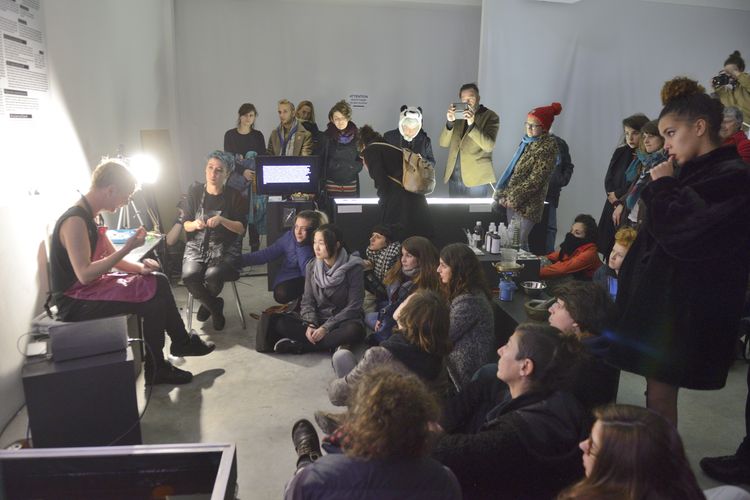
Their biopunk sci-fi dream is not so new. It dates back to the 1920s, when the first scientists began to study marine organisms (slugs, worms, etc.) that nourished themselves either partly or wholly through photosynthesis generated by the chloroplasts of algae they hosted in their skin (Makery covered this last year). Closer to us, Lynn Margulis, biologist of endosymbiotic theory and co-author with James Lovelock of the Gaia hypothesis, imagined a “homo photosyntheticus” who would feed himself by sunbathing on the beaches of the solar system…
Even more recently, in his short story Oral Argument published in December 2015 at the time of COP21, science-fiction author Kim Stanley Robinson offered a glimpse of a future in which synthetic biologists find in the iGEM Registry “biobricks” that can be combined to create a synthetic chloroplast and photosynthesizing human cells. In Robinson’s story, biologists modify tattoo needles to inject chloroplast-fibroblasts into human skin, like an ordinary tattoo. They start a company called Sunskin, but soon decide to make their work open source, as photosynthesis is a natural process. This disrupts the balance of the planet (for more details, read “Becoming a Phototroph” in the January 2016 of the journal Laboratory Planet).
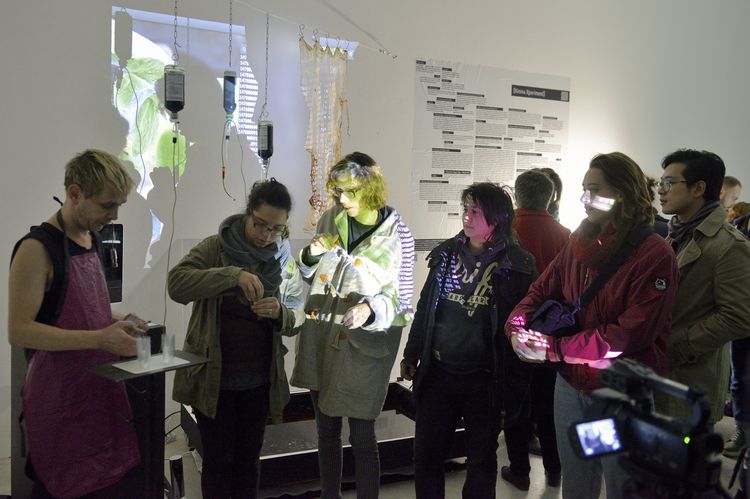
Chlorophyll tattoo
At Bandits-Mages, Quimera Rosa gave willing visitors tattoos of eastern emerald elysia (elysia chlorotica), a sea slug with a photosynthesizing epiderm. Unlike Robinson’s synthetic biology, Quimera Rosa’s is still artisanal, using chlorophyll ink. “We use two chlorophylls. The first, non-photosynthesizing, is a chlorophyll modified for nutritional use that we bought and mixed with the usual tattoo ink products [sodium copper chlorophyllin, a vegetable food dye, 100 ml of witch-hazel, a plant often used to strengthen the blood vessels, 5ml of propylene glycol and 5ml of medical glycerin]”, the duo explains. The second ink was conceived during the performance itself, using “a very simple alcohol extraction, with the means at hand, to constitute a living ink, which is checked for its photosensitivity to ultraviolet rays, that we use for tattooing”. Cé then used these two inks to tattoo Kina on the spot, drawing the contours of the elysia with the non-photosynthesizing ink and coloring it in with the other photosensitive ink.
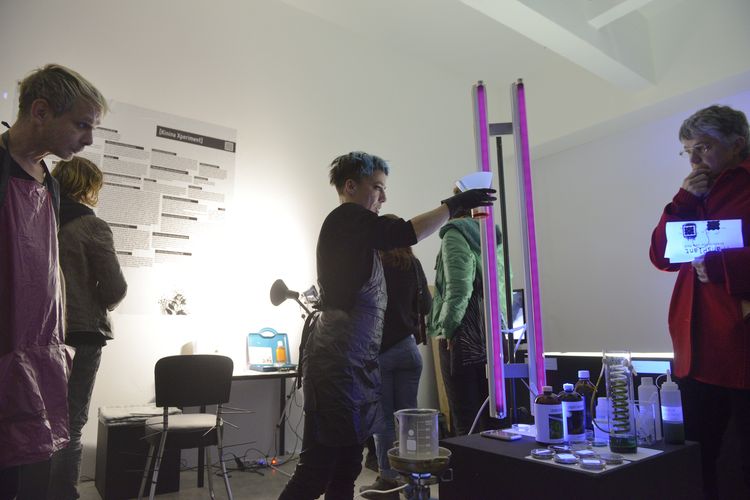
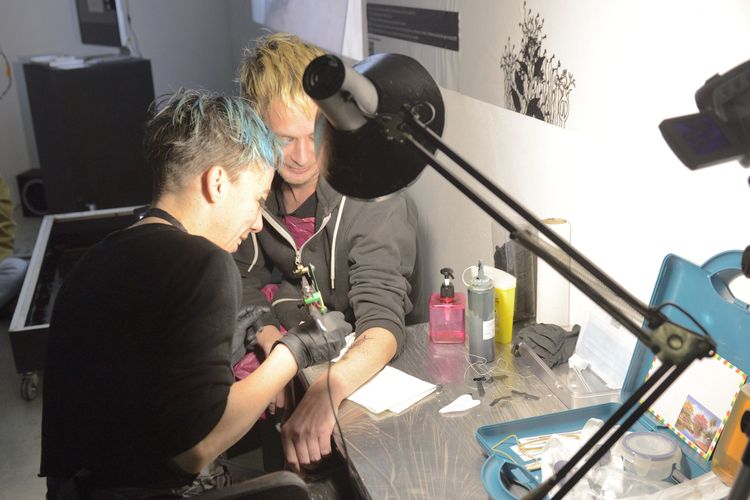
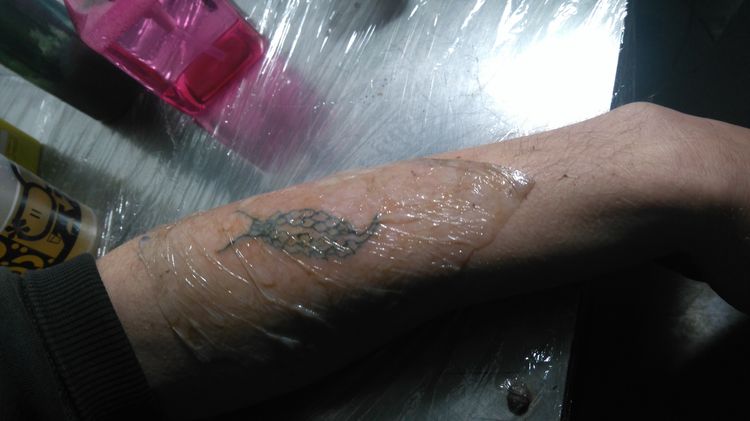
Somathèque
This phase is only one of the phases of Transplant: Green is the new Red, an open source “transdisciplinary bioart project on a plant/human/animal/machine hybridization” that will be developed over the following years. Transplant creates a dialogue between disciplines such as arts, philosophy, biology, ecology, physics, botany, medicine, nursing, pharmacology and electronics. Based on various biohacking practices, Quimera Rosa seek to “produce changes in subjectivity and deconstruct different types of narratives that present the body as a unit. For now, these axes are: hybridizing human blood with chlorophyll through the regular protocol of intravenous injections, translating the process externally into chlorophyll tattoos, implanting an electronic RFID chip to store the data from the process and present the body as a somathèque [collection of somatic cells], developing and connecting the body to plant sensors (environmental acidity level, specific electromagnetic waves…) and body activity feedback, medical self-experimentation on condylomata acuminata (genital warts), building a public open source database of the experiments.”
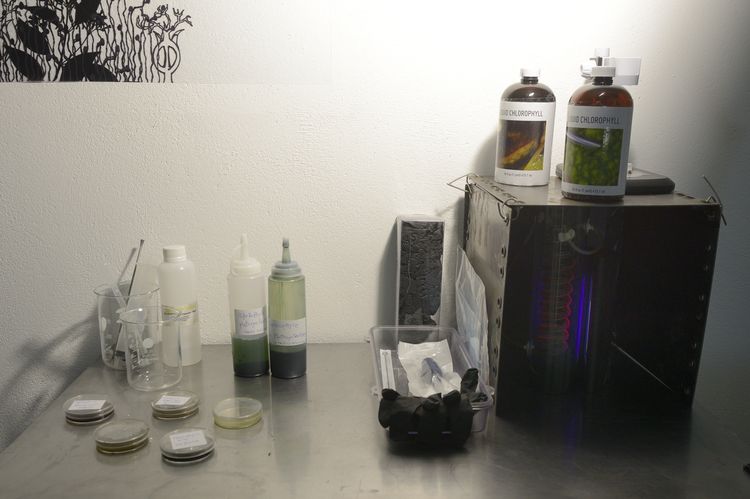
Becoming a cyborg
Last August, Yan had an RFID chip implanted and changed her name to Kina, a way for the Quimera Rosa member to reaffirm her “human-to-plant transition”. The chip that Kina had implanted is an open, non-detectable version of tracking technology. “With its greater capacity, we can imagine new, non-standard uses for this technology. We could transform an identification technology into a post-ID technology used to hack what we call being human.” Through this transition process, Yan/Kina wants social recognition of “the loss of my human condition and the adoption of a new name”, albeit with a certain irony regarding this supposedly “crazy” decision:
“I’m not sure I want to be a guinea pig for psychiatrists wanting to verify if I feel like a plant trapped in the body of a human, so that they can invent a reigning dysphoric disorder, or if my photosynthetic desire is not just an extreme manifestation of repressed anorexia, or even if my admiration of vegetal silence is not simply proof of a conspiratorial and asocial tendency.”
Kina of Quimera Rosa
Kina reminds us that dogs and other animals have been microchipped well before humans, and that her transition is also “becoming a cyborg”, in the sense of American philosopher Donna Haraway’s Cyborg Manifesto.
“The first cyborg was a mouse, developed in a laboratory in the 1960s during the space race. Becoming a cyborg is above all becoming an animal, in spite of the transhumanists and their dreams of improving the human species through its fusion with technology.”
Kina of Quimera Rosa
“I am a dog. Or rather, a bitch. Basically, don’t confuse Haraway’s Cyborg Manifesto with Hollywood’s Terminator Manifesto. My desire is not to become more human, but less human. It’s not really even a desire to become a plant, but to hybridize with the vegetal, to become with.”

DIY cancer treatment
To explain their approach of injecting chlorophyll, Quimera Rosa finally confide that it’s more of a biomedical experiment on condylomas (genital warts) and the human papillomavirus (HPV), responsible for a number of sexually transmitted infections. “We want to do a DIY experiment in photodynamic therapy, which consists of injecting chlorophyll and projecting a laser into it,” says Kina. “HPV is a sexually transmitted virus, currently one of the most present, but it remains relatively hidden, and there isn’t a lot of information out there.” The virus is a known factor of cervical cancer. “We realized that the studies are often done on bodies with ovaries, but the studies on bodies without them are not as developed,” says Cé. Both Quimera Rosa members add:
“Photodynamic therapy is used in skin oncology, it’s a precursor. It already works very well on localized cancers, but it’s not yet accessible enough. The cure rate is very high, the body invasion rate is very low. Through this medical self-experiment on condylomas, we also want to develop and distribute knowledge of this therapy.”
Quimera Rosa
So far, Quimera Rosa have learned methods of extraction and infusion. Now they are looking for collaborations for biomedical follow-up and establishing protocols for the transfusion phase. Meanwhile, they also want to do it themselves, regularly. To be continued…
Quimera Rosa’s “Transplant” installation is on view through January 8, 2017 in the exposition «Entropia» at Transpalette art center in Bourges, France
